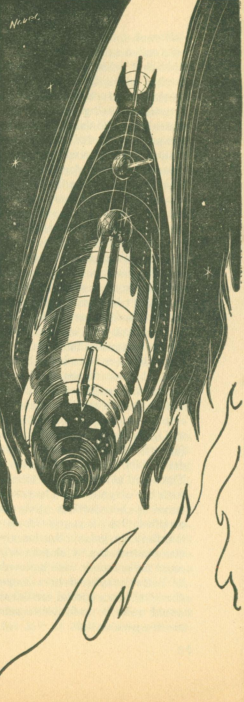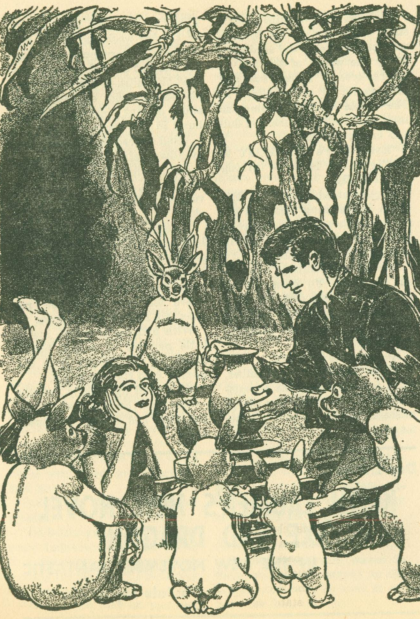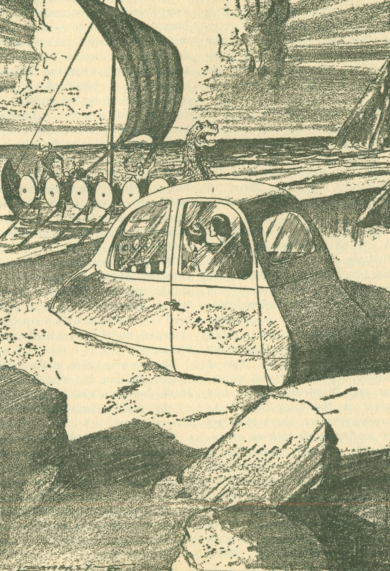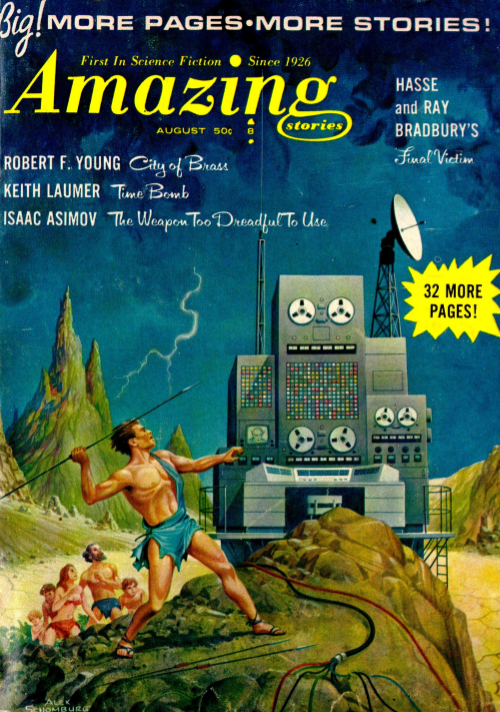
by John Boston
Amazing, A.L. (after Lalli)
The shape of the post-Ziff-Davis Amazing and the new publisher’s reprint policy become much clearer in this October issue. There are seven items of fiction here, and five of them are reprints, comprising about 55% of the magazine’s page count. If this issue is typical, Amazing is drastically shrinking as a significant market for original fiction.
The two new fiction items are the first part of a two-part serial by Murray Leinster, whose future seems mostly to have been behind him for some years now, and yet another Ensign De Ruyter short story by Arthur Porges. There is also another in the series of scientific hoax articles by Robert Silverberg.
There’s an editorial, this time by managing editor Joseph Ross, rather than by Sol Cohen, “editor and publisher” on the masthead. Ross shows himself to be as boring a writer as Cohen in his paean to Murray Leinster, the Dean of Science Fiction. The letter column, now just called Letters, reappears, with one very long letter praising the new Amazing by someone who has bought the first Cohen issue, but hasn’t actually read it. The point is elusive. The mediocre cover is by Frank Kelly Freas, probably bought at a rummage sale or something; Freas has never appeared on Amazing’s cover before.

by Frank Kelly Freas
With all these inauspicious signs, it’s a bit surprising that the contents of the issue are a considerable improvement over the previous one, the first of the Cohen/Ross regime.
Killer Ship (Part 1 of 2), by Murray Leinster

by Nodel
As is my practice, I’ll withhold comment on Killer Ship, the Leinster serial, until it’s finished, pausing only to note that Leinster seems to have taken up a hoary theme: space pirates! And he begins on a determinedly vintage note: “He came of a long line of ship-captains, which probably explains the whole matter.” Hope struggles with trepidation.
The Eternal Eve, by John Wyndham
John Wyndham’s The Eternal Eve, from the September 1950 Amazing, begins as the protagonist Amanda sees a man approaching the cave she is living in and shoots him with her rifle. She then pushes his body over the nearby cliff to be eaten by the giant crabs that live on the beach below, this being Venus. From there, a flashback: Amanda has come to Venus for an 18-month job assisting an anthropological expedition. But Earth blows up, leaving nobody alive but the modest colony on Venus and those humans who were on Mars or in space at the time.

by Rod Ruth
Order starts to erode in the obvious ways, one of which is pressure for Amanda to pair off with one of the men. She’s not interested, and creates a diversion allowing her to slip off with her rifle and some supplies and set up housekeeping on her own, with the help of the childlike Venusian griffa. Eventually she realizes she can’t live happily completely outside human society, so she gives in and comes back, facilitated by the appearance of Mr. Right, but not before she shoots him too. Not fatally, though: think of it as romantic comedy, cordite replacing the flowers.
I’ve made this story sound a bit reactionary; not so. Wyndham is actually pretty sensitive to the dilemmas posed for independent-minded women by the demands of male-dominated society, even if he doesn’t solve them in this story. He's continued to chew on this theme in his later work, most notably the novella Consider Her Ways from the mid-1950s. He is also a much more capable writer at the word and sentence level than most Amazing contributors, new or old, making this story a pleasure to read. Am I really saying four stars? Guess so.

by McClish
Ray Bradbury’s Chrysalis, from the July 1946 issue, is much better than the execrable Final Victim from the last issue, though considerably cruder than the stories he puts in his collections. Man here (Smith) has turned green and his skin has become a hard shell; also his metabolism has slowed almost to nothing. He is being watched over by Dr. Rockwell (the sensible and inquiring one), Dr. Hartley (the near-hysterical one), and Dr. McGuire (the nebbish of the bunch). Young Mr. Bradbury seems to have been spending a bit too much time at the movies, or else he’s aspiring to work for them, since the story proceeds mainly through scenes of these characters swapping reasonably sharp dialogue, while Smith continues being green and seemingly unconscious as strange transformations continue underneath the green shell. Dr. Rockwell broaches the possibility of superman, or super-something, and shortly, the story’s title is enacted, unfortunately a bit anticlimactically. The story is a bit too long, but the author moves it along capably. Three stars.
The Metal Man, by Jack Williamson
Jack Williamson’s first published story, The Metal Man, from the December 1928 issue, has not worn well. There’s a very lifelike metal statue of a man standing in the Tyburn College Museum—lifelike because it used to be Professor Kelvin of Geology, who got rich prospecting for radium. Now he has been delivered in his statuesque form to his old friend, the narrator, in a wooden chest, along (of course) with his manuscript. This recounts the Prof’s journey to El Rio de la Sangre, the River of Blood, which is highly radioactive. He’s looking for the source, resorting to a small airplane whose parts he assembles on-site when he gets as far as a boat will take him.

by Frank R. Paul
He winds up in a strange, colorful lost world. Very colorful. The river is like a red snake, and it goes underground and emerges in a mountain crater that holds a pool of green fire, extending to the black ramparts of the other side of the crater, while “the snow-capped summits about were brilliant argent crowns, dyed with crimson, tinged with purple and gold, tinted with strange and incredible hues.” A silver mist begins to descend. The green lake rises up to a shining peak, and from it emerges—“a gigantic sphere of deep red, marked with four huge oval spots of dull black,” its surface “thickly studded with great spikes that seemed of yellow fire”!
This is all in the space of a few paragraphs. After a brief respite, Prof. Kelvin finds his plane and himself covered with a pale blue luminosity, he is drawn down into the green (gaseous) lake to land, stumbles around and trips over a bird that has turned to metal, foreshadowing his own fate. He has more adventures (also very colorful, but enough of that) as he blunders around in this strange world created by lots of radioactivity, becoming more metallic as he goes. Unfortunately there’s not much more to the story than this parade of menacing wonders, made possible by the fact that back then nobody really knew that much about the effects of radioactivity. Two stars.
It should be noted that Williamson went on to produce The Green Girl, Through the Purple Cloud, The Stone from the Green Star, Red Slag of Mars, In the Scarlet Star, and Golden Blood, all within the next five years. The visible spectrum seems to have been a good career move for him.
The Time Jumpers, by Philip Francis Nowlan

by Leo Morey
Philip Francis Nowlan, perpetrator of the Buck Rogers Yellow Peril epics, is here in a lighter mood with The Time Jumpers (February 1934 Amazing), a mildly amusing period piece (albeit with certain period attitudes) about a guy who invents a time car and, with his platonic girlfriend, first narrowly escapes from marauding Vikings, possibly Leif Ericson’s outfit, then makes a longer foray into the Colonial period, narrowly escaping from marauding Indians, briefly meeting the young not-yet-General Washington, and then narrowly escaping from a French officer and his marauding Indians. Two stars.
Dusty Answer, by Arthur Porges
Dusty Answer is yet another of Arthur Porges’s tales of Ensign De Ruyter, notable chiefly for the excruciating tedium they achieve in relatively few pages. Their formula is clever Earthmen outwitting stupid and primitive aliens through elementary science tricks, this time the ignition of dust suspended in air. One star, if that.
The Kensington Stone, by Robert Silverberg
Robert Silverberg’s scientific hoax article, The Kensington Stone, concerns the finding and subsequent career of an inscription found in Minnesota which purported to show that the Norse Vinland settlement of Leif Erikson (yeah, him again, spelled a little differently) had sent an expedition as far as Minnesota. This one is just as well written as its predecessors, suffering by comparison only because the underlying story is less captivating, with no picturesque fraudster at its center. Three stars.
Summing Up
So: whatever one thinks about the new reprint policy at Amazing and Fantastic, new editor Ross has managed this month (or bi-month) to put together a decently readable issue. Question is how long he can keep it up.
[Speaking of books, Journey Press now has three excellent titles for your reading pleasure! Why not pick up a copy or three? Not only will you enjoy them all — you'll be helping out the Journey!]

![[September 12, 1965] So Far . . . Well, Fair (October 1965 <i>Amazing</i>)](https://galacticjourney.org/wp-content/uploads/2020/09/amz1065-cover-497x372.png)


![[July 14, 1965] The New Dispensation (August 1965 <i>Amazing</i>)](https://galacticjourney.org/wp-content/uploads/2020/07/amz0865-cover-500x372.png)






![[May 12, 1965] Da Capo (June 1965 <i>Amazing</i>)](https://galacticjourney.org/wp-content/uploads/2020/05/amz-0665-cover-391x372.png)

![[March 12, 1965] Sic Transit (April 1965 <i>Amazing</i>)](https://galacticjourney.org/wp-content/uploads/2020/03/amz-0465-cover-672x372.png)


